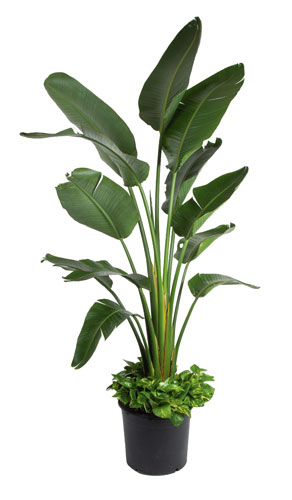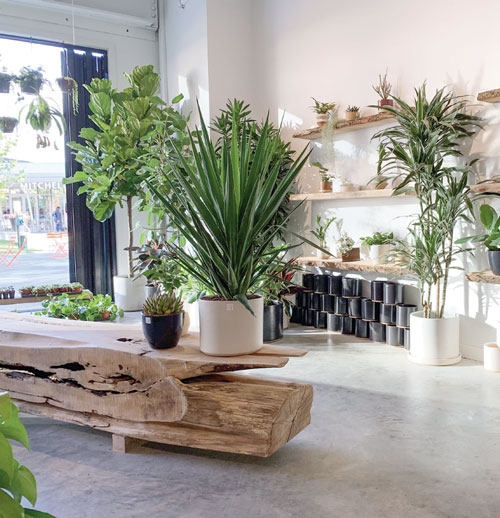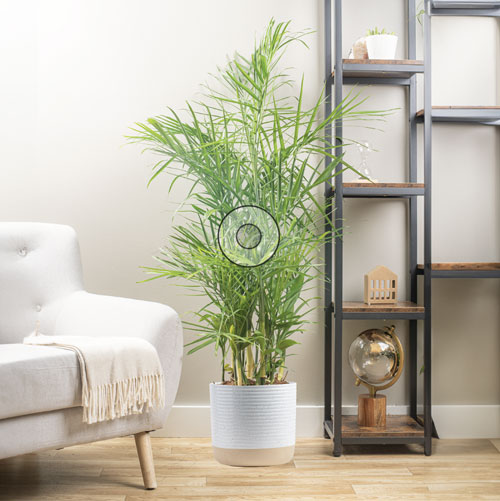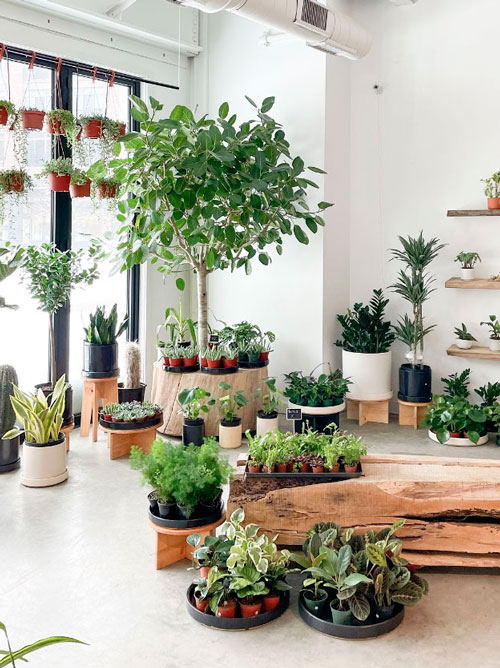4/30/2025
Go Big With Tall Foliage
Jennifer Polanz

The houseplant market seems to be plateauing, with sales remaining somewhat steady after a powerful climb for a couple of years pre- and post-COVID. So where can retailers nudge sales up to create more interest and appeal? One place to look is larger foliage (another is rare plants and new introductions), and I was surprised to hear a couple of ways where smaller plants can encourage sales of larger plants and vice versa.
Left: Combinations aren’t just for annuals and perennials. You can make them with houseplants, too—this is a Bird of Paradise combined with a Golden Pothos.
Photo courtesy of Costa Farms.
But before we get into that, let’s talk about nuance. There are some things to know about carrying these larger items indoors that differ from the smaller plants, as well as outdoor larger specimens. I tapped two experts for more details because this is an area where I didn’t know what I didn’t know (if you know what I mean).
The Room to Go Big
First off, space is a premium for the indoor houseplant sales floor and no one knows this better than Emily Kellett, owner of STUMP, an independent chain of six plant shops in Ohio, Pennsylvania and Georgia (she was also one of our Young Retailer Award finalists in 2023). Her shops tap out at around 1,500 sq. ft., so she has to be discerning with what she orders. She recommended starting with only a few larger items—around four to five— at 14-in. pot sizes (which can range from 5- to 6-ft. tall) until customers start to know you as a source for such products. She’ll typically order Fiddle Leaf Figs (Ficus lyrata), Ficus Audrey (Ficus benghalensis), Rubber Tree (Ficus elastica), dracaenas like Dracaena fragrans Janet Craig Compacta, Dracaena reflexa Song of Jamaica and Song of India, and ponytail palms (Beaucarnea recurvata), among other larger specimens. She noted she stays away from ordering Ficus benjamina, commonly known as Weeping Fig.
“Those are the ones we kind of stick to because when you get to the F. benjamina, I mean, I know they do really well indoors, but they drop a lot of leaves, especially at first, and people always freak out,” she said, adding if the customer requests it they can oblige. “If it’s a special request, we can always order them in and that’s fine.”
In the retail space and in the home, it’s vital these larger items get the light they need. That’s one of the bigger parts of education that Emily’s specialists in store emphasize. As you can see in the photos, they have stores with large windows for lots of light, and that’s the same thing customers need, all the way up to the tree canopy. If the plant requires high light, it needs to go right in front of the window, she said, not to the side. At checkout they write out a care card that has the name of the plant, light requirement and watering needs.
 Justin Hancock, director of research and development and horticulture content at Costa Farms, noted that when it comes to watering, care is the same, too, in the store and in the home. And just because it’s a larger plant doesn’t mean it needs excessive amounts of water.
Justin Hancock, director of research and development and horticulture content at Costa Farms, noted that when it comes to watering, care is the same, too, in the store and in the home. And just because it’s a larger plant doesn’t mean it needs excessive amounts of water.
Right: STUMP merchandises their larger trees and plants in a decorative pot, and when a customer purchases they ask if they’d like to buy the pot, drainage tray and cork mat with it.
Photo courtesy of Emily Kellett, STUMP.
“It needs the same ratio of water to soil that the same version in a smaller pot size would need,” he said. “It’s certainly a larger quantity of water than the same plant in a smaller size, but proportionally it’s the same.”
He added that both retailers and customers should watch for drafts from vents near the plant canopy, which can sometimes be upwards of five to six feet higher or more than the rest of the plants and may otherwise go unnoticed.
The Logistics of Big Plants
There are several things to keep in mind related to larger items when it comes to loading and unloading, and consideration for how customers are going to shop and get their new “baby” home. For example, Justin said to be cognizant of your cart situation. They’ve actually talked retail customers out of carrying certain larger sizes because they didn’t have the right carts for the end consumer to transport them with. Retailers should consider how the customer will select their larger plant, get it into or on a cart (or notify the cashier they’d like to purchase it) and how they’ll get it to the car or home.
Will you offer delivery on larger items like that? That’s a whole host of new considerations, and Emily said, while they used to offer delivery, they stopped. Now they bag up the bottom of the potted portion so the soil doesn’t spill out, use a cart to wheel the plant out and help the buyer get it in their vehicle.

“We just stopped doing it and people keep buying trees. They just figured it out,” she said, adding if you already have delivery service then it can be an option.
Bamboo palm, also known as parlor palm, is a larger, low-light option for retailers to consider carrying.
Photo courtesy of Costa Farms.
Another service that can go along with delivery is repotting at the customer’s house, Emily said. That would have its own fee and customers would feel confident knowing a professional was handling their large tree without having to bring it back to the store.
Justin said, too, training employees on how to load such plants into vehicles can make a big difference. “Having staff who feel confident loading the car without breaking it helps because some of the plants—once you get to a large size—if you break one branch, that makes a very visible difference,” he added.
Weight is a consideration, too, and a watered plant is a heavier plant. When you start talking about 14- to 17-in. containers, that gets real heavy real fast. So having a plan in place for transporting plants makes the sale a lot smoother.
Little Sells Big And Vice Versa
An interesting concept Justin noted is the idea of pairing larger, 14-in. towering plants with their smaller counterparts in 4-in. or 6-in. pots to sell all sizes. This achieves a couple of goals. One, it shows the customer just how big that plant can get. They may not be able to afford the larger one right then, but they could certainly buy the smaller one with that future tree in mind. You also have an opportunity to sell the products needed to get them there, like a series of pots, fertilizer, etc.

Two, the mannequin concept plays on the idea of instant gratification. Sure, you could buy the 4-in. pot, but if you want to fill a big space right now, the larger one is what you want.
Right: Note how the window is taller than the tree in this photo from STUMP’s Van Aken District store in Shaker Heights, Ohio, so the full canopy gets the benefit of the light.
Photo courtesy of Emily Kellett, STUMP.
Justin noted that the difference between the smaller plant and larger one could be a year or so at a professional grower, but in the home of the average consumer it would take much longer. There’s also another factor—larger plants are usually easier to care for, something not a lot of consumers are aware of.
“I try to focus on that, the patience factor, the immediate gratification factor and really driving home that it’s worth the investment,” he said of the larger items. “I think that larger plants are easier to care for than small plants. There’s more of a root system. It’s more established.”
Emily agreed with that: “I think people can be intimidated by the size, but then you just have to tell them, no, it’s actually easier. Most of the plants I have in my house are 12-in. and larger, just because I don’t like to water. They take longer to dry out and they’re more forgiving.”
Ordering and Pricing
Emily orders from a broker for her material, and she recommends going to TPIE in January to find growers and new plant material. They get plant shipments every one to two weeks and typically order one to two larger items per shipment per store. The 14-in. material sells in waves, she said, and they don't often sell larger than that routinely. She said the really large 17-in. plants (that reach up to 9- to 10-ft. tall) only sell a couple of times a year for them.
There are other product considerations, too, to go along with the larger plants. The obvious is pottery and containers, of which they stock enough for display.
“We just set the grow pot inside of it and that’s how we put them out and merchandise it,” she said. “So whenever someone says that they want to buy the tree, then we always ask if they want the pot and the drip tray to go with it, and the cork mat to put under the drip tray.”
The cork mat saves flooring from any sweating that happens under the drip tray. They also stock Sustee moisture meters because it can be difficult to determine if a larger tree is watered appropriately. Other products to consider carrying include watering cans, fertilizer, leaf-cleaning gloves (they stock We the Wild brand), pest control products, media for repotting and pruners for the larger items.
Justin added another large item and product to go with it: a totem with a climbing aroid, whether it’s a monstera, pothos or philodendron. This gives retailers an opportunity to sell the pot, the plant and the pole together.
“Those are just so darn trendy right now, and they look spectacular when they’ve been growing and they start to size up,” he said. “In the Flower District in New York, there are a couple of shops that I love walking through because they do have these pothos that are on totems taller than me. And it gives you that chance to have a leaf that’s 18-in. wide.”
With all these different styles of product, how do you go about pricing? First, consider what goes into this product that doesn’t go into its smaller counterparts. There tends to be more labor involved, with employees helping customers transport and load. They may stay around a little longer than the smaller items, requiring more watering and other general care. And the freight cost per larger item is naturally going to be more due to their weight and size.
“The bigger the plant, the more expensive it is going to be to ship and get it to you, the higher you’re going to have to mark it up,” Justin said.
Emily noted there’s a little more wiggle room for markup with the larger plants due to all the factors involved, so consider what you have in the product and what your market can bear when looking at your pricing.
Other opportunities with these plants include workshops to talk about repotting and pruning, as well as detailed care sheets and online resources to help customers stay successful. When cared for properly, these are investments that can really pay off in enhancing interior design, and making a home brighter and more beautiful. GP